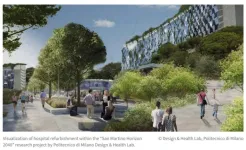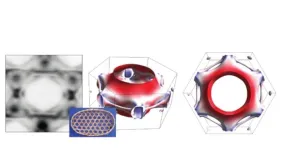(Press-News.org) Milan, 9 June 2023 - The World Health Organisation presented in Baku (Azerbaijan) the new design recommendations for new hospitals to be built in the European Region, the result of a research partnership with the Politecnico di Milano. The document was prepared by the Design & Health Lab in the Department of Architecture, Construction Engineering and the Built Environment at the Politecnico under the coordination of Professor Stefano Capolongo.
The COVID-19 pandemic highlighted the importance of preparedness for natural and man-made disasters, emergencies and other social crises. The ability to provide continuous health services is crucial in these situations, and designing an architecture for health is the key route towards tackling the multiple factors that are transforming society, the economy and the environment.
Hospitals are particularly important because they best interpret these transformations, promote urban regeneration and have a widespread positive impact in a given area. For a hospital to remain functional during emergencies and disasters, it must be designed with a solid and flexible infrastructure, high resistance to hazards and with particular focus on safety and comfort.
The COVID-19 pandemic also underlined the importance of the hospital environment in the transmission of pathogens and highlighted the need to ensure sustainable compliance with hygiene standards.
“What will the hospital of the future look like? We are already in the future: technology, design and organisational solutions have reached very advanced levels,” says Professor Stefano Capolongo, director of the Department of Architecture, Construction Engineering and the Built Environment at the Politecnico di Milano, “The challenge today is to systemise all principles aimed at sustainable, inclusive development from a One Health perspective. The technical brief prepared for the World Health Organisation brings together the main strategies for the implementation of flexible, resilient and evidence-based innovative hospitals throughout the European region.”
The guidelines are designed for health institutions, health organisations and their governance bodies: the general managers, but also architects and technicians who work on health infrastructure.
The recommendations address future challenges from different points of analysis. Firstly, the choice of hospital location, with different functions depending on whether it is located in the city centre or in the suburbs (the latter capable of serving larger areas). The focus then shifts to the importance of green areas for the benefit of patients and medical staff and the well-being of workers.
The spaces need to be designed so as to be accessible to all segments of the population, including in terms of aesthetics, both inside and outside the hospital.
At managerial level, digitisation makes a significant contribution, greatly facilitating the management of goods and services in the hospitals and the organisation of work and services in the local area.
The hospital of the future must not be closed and unchangeable: synergies with the local health network can improve services and the resilience of the health system and facilitate patient access to local medical services.
In planning, we must be aware of the risks of infection within hospitals, and therefore pay due attention to air quality control in design and construction, which must include hygiene management.
The hospital of the future is socially, economically and ecologically sustainable, with a strategy that is integral to the entire life cycle of the facility, including energy and resource management, and its possible adaptations and extensions.
Prevention and safety are essential, from the point of view of both general safety and the risk of fire and seismic events; an issue that must be addressed comprehensively: design and construction, maintenance, training and emergency preparedness.
END
WHO recommends Politecnico di Milano guidelines for the design of future hospitals
2023-06-09
ELSE PRESS RELEASES FROM THIS DATE:
3D 'bio-printing' inside hydrogels
2023-06-09
Scientists from the NIHR Great Ormond Street Hospital Biomedical Research Centre (a collaboration between GOSH and UCL), London, and University of Padova, Italy, have shown for the first time how 3D printing can be achieved inside ‘mini-organs’ growing in hydrogels -- controlling their shape, activity, and even forcing tissue to grow into 'moulds.'
This can help teams study cells and organs more accurately, create realistic models of organs and disease, and even better understand how cancer spreads through different tissues.
A particularly promising area of research at the Zayed Centre for Research ...
Scientists make a surprising discovery about magnetic defects in topological insulators
2023-06-09
Scientists from the Department of Energy’s Ames National Laboratory made an intriguing discovery while conducting experiments to characterize magnetism in a material known as a dilute magnetic topological insulator where magnetic defects are introduced. Despite this material’s ferromagnetism, the team discovered strong antiferromagnetic interactions between some pairs of magnetic defects that play a key role in several families of magnetic topological insulators.
Topological insulators (TIs) as their name indicates, ...
Novel ferroelectrics for more efficient microelectronics
2023-06-09
When we communicate with others over wireless networks, information is sent to data centers where it is collected, stored, processed, and distributed. As computational energy usage continues to grow, it is on pace to potentially become the leading source of energy consumption in this century. Memory and logic are physically separated in most modern computers, and therefore the interaction between these two components is very energy intensive in accessing, manipulating, and re-storing data. A team of researchers from Carnegie Mellon University and Penn State University is exploring materials that could possibly lead to the ...
Quantum materials: Electron spin measured for the first time
2023-06-09
An international research team has succeeded for the first time in measuring the electron spin in matter - i.e., the curvature of space in which electrons live and move - within "kagome materials", a new class of quantum materials.
The results obtained - published in Nature Physics - could revolutionise the way quantum materials are studied in the future, opening the door to new developments in quantum technologies, with possible applications in a variety of technological fields, from renewable energy to biomedicine, from electronics to quantum computers.
Success was ...
Seismic Waves tell lithospheric delamination mechanism in south China
2023-06-09
A research team led by Prof. ZHANG Haijiang from the University of Science and Technology of China (USTC) of the Chinese Academy of Sciences, and Prof. HOU Zengqian from Chinese Academy of Geological Sciences, revealed the seismically imaged lithospheric delamination and its controls on the Mesozoic Magmatic Province in South China by using a new joint seismic inversion algorithm. The study was published in Nature Communications.
Based on the latest developed seismic joint inversion algorithm, the researchers made use of the seismic body wave travel time, surface wave dispersion ...
Program for underrepresented undergraduate students in STEM receives NIH funding
2023-06-09
Alexandra Hanlon, director of the Virginia Tech Center for Biostatistics and Health Data Science, was recently awarded a $1.25 million grant from the National Institutes of Health (NIH) for a summer program aimed at promoting and diversifying the field of collaborative biostatistics.
The Collaborative Undergraduate Biostatistics Experience (CUBE), an eight-week summer program geared toward underrepresented undergraduate students, will receive $250,000 per year over the next five years through the NIH Research Education Program.
This R25 award, which is funded in a joint effort ...
USTC enhances fluorescence brightness of single silicon carbide spin color centers
2023-06-09
In a study published online in Nano Letters, the team led by Prof. LI Chuanfeng and Dr. XU Jinshi from the University of Science and Technology of China of the Chinese Academy of Sciences made progress in enhancing the fluorescence of single silicon carbide spin defects. The researchers leveraged surface plasmons to markedly boost the fluorescence brightness of single silicon carbide double vacancy PL6 color centers, leading to an improvement in the efficiency of spin control using the properties of co-planar waveguides. This low-cost method neither calls for complex micro-nano processing ...
Researchers determine quantitative composition of ultrahigh-pressure fluid in deep subduction zones
2023-06-09
In a study published in PNAS, Prof. XIAO Yilin’s group from the University of Science and Technology of China (USTC) of the Chinese Academy of Sciences (CAS) quantitatively determined, for the first time, the chemical composition of supercritical fluids in deep subduction zones, through 3D imaging modelling of ultrahigh-pressure (UHP) multiphase fluid inclusions, and revealed the important role of supercritical fluids in the cycling of carbon and sulfur in subduction zones, which is of great importance ...
USTC reveals reconfiguration process of solar eruptions
2023-06-09
Recently, a research team led by Prof. GOU Yanyu from the University of Science and Technology of China (USTC) of the Chinese Academy of Sciences (CAS) found that the solar outburst structure undergoes a complex reconfiguration evolution during the early outbursts, thus making important advances in the study of solar outburst activity. This study was published in Nature Astronomy.
In classical images, the core structure of a solar eruption is a magnetic rope consisted of spirally wound magnetic lines. When the eruption begins, the magnetic ropes around the core are transformed by magnetic reconnection ...
DNA facilitates escape from metastability
2023-06-09
Prof. LIANG Haojun from the University of Science and Technology of China (USTC) of the Chinese Academy of Sciences (CAS) proposed a new method to escape from metastability for self-assembly in a far-from-equilibrium system. The study was published in PNAS.
Self-assembly refers to the process in which assembled primitive elements (molecules, nanoparticles, etc.) spontaneously form ordered structures through non-covalent interactions. Its excellent capacity to create new materials has drawn attention. In an ...


